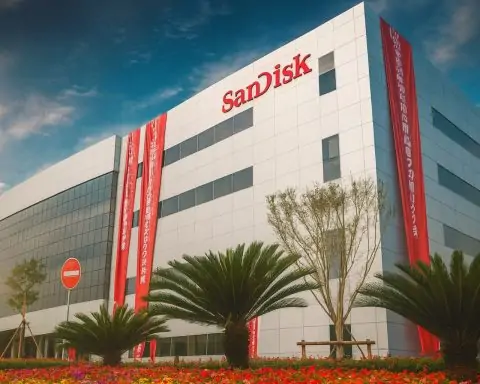- Stock Near 2025 Highs: Iren S.p.A.’s share price hovers around €2.56 as of November 3, 2025, roughly flat on the day [1] and up over 30% year-to-date [2]. It trades near the upper end of its 52-week range (€1.85 – €2.81) after a strong rally this year.
- Recent Pullback & News: After a ~40% surge since January, Iren’s stock saw a late-October pullback (~–6% in the last 10 days of the month) amid analyst downgrades [3] [4]. Both Kepler Cheuvreux and Equita SIM cut their ratings to “Hold” ahead of Iren’s upcoming Q3 results and new strategic plan release on Nov. 13 [5] [6].
- Analysts Turn Cautious: Experts praise Iren’s solid financials and market position but warn the stock’s valuation now fully reflects its prospects. Kepler cites “limited upside” after the year’s big gains [7], and Equita sees moderate growth ahead with 2026 earnings likely only in line with peers [8]. Consensus 12-month price targets cluster around €2.8–€2.9, just ~5–10% above current levels [9] [10].
- Forecasts – Near Term vs. Long Term: Technical indicators are weak in the very short term, with Iren deemed a “Sell candidate” by one model as of Oct 31 [11]. However, over the next few months the stock is still projected to drift modestly higher (potentially +5–7% in 3 months) barring new shocks [12]. Longer-range forecasts hinge on the new 2025–2030 business plan: Iren is expected to target steady growth (EBITDA +~6% CAGR through 2030) [13], but analysts project slightly lower growth (~3–5% CAGR) and are pricing the stock accordingly [14].
- Financially Robust 2025: Iren delivered strong results in H1 2025 – revenue jumped 29% to €3.49 billion and net profit climbed 24% to €184 million [15]. EBITDA for full-year 2024 hit €1.27 billion, topping guidance, and 2025 EBITDA is guided at €1.34–€1.36 billion [16]. The company’s dividend is growing (~€0.128 per share in 2025, ~5% yield) and is projected to increase ~5–8% annually going forward [17] [18].
- Strategic Plans & ESG Focus: As a leading Italian multi-utility, Iren is investing heavily in infrastructure, renewables, and waste management. Its new industrial plan through 2030 is expected to entail multi-billion-euro capex (over €8 billion, ~85% earmarked for sustainability and service quality) [19]. Iren has earned solid ESG marks (e.g. a “B” climate score from CDP and MSCI ESG rating of BBB [20] [21]) and even opened one of Europe’s first low-carbon recycling plants for electronic waste to cut CO₂ emissions by two-thirds [22].
- Macro Tailwinds & Risks:European utility stocks have been in favor in 2025, rebounding from 2024’s declines. Lower interest rates and resilient power demand helped push the European utilities index up by double digits, outperforming the broader market [23] [24]. For Iren, Italy’s improving macro picture is a boon – Fitch upgraded Iren’s debt rating to BBB+ in September after Italy’s sovereign upgrade [25]. Still, sector challenges remain: rising bond yields could pressure this dividend-paying stock, regulatory delays (e.g. on hydroelectric concession renewals) temper some upside [26], and competition in green investments means Iren must execute its plan efficiently to meet growth and ESG goals.
Current Stock Performance (Nov 3, 2025)
Iren’s stock is trading around its year-to-date highs as we enter November. On November 3, 2025, shares traded roughly €2.56 on the Borsa Italiana, essentially unchanged on the day [27]. The price is not far below the 52-week peak of €2.81, reflecting the substantial gains achieved over 2025. In fact, Iren’s stock has climbed over 30% since January (about +33% YTD) [28], significantly outperforming the broader Italian market. For context, the shares started the year near €1.90 and have rallied amid strong earnings and a sector-wide rebound.
This recent strength puts Iren near the upper end of its 1-year range (€1.85–€2.81) [29], a remarkable turnaround from 2022–2023 when utility stocks lagged. The average trading volume remains healthy, and at current prices Iren’s market capitalization is around €3.3 billion [30]. Notably, Iren offers an attractive dividend yield (circa 5% at current price) [31], which has drawn income-focused investors during a time of easing interest rate pressures.
However, the stock did hit some turbulence at October’s end. After peaking in mid-October, IRE.MI pulled back in the final week of the month – the share price slid from about €2.70 to €2.56, a ~5–6% decline [32]. This pause in the rally coincided with profit-taking and cautious signals from analysts (as detailed below). Still, as of early November, Iren is holding onto the bulk of its 2025 gains, and its 12-month performance is comfortably positive. The question on many investors’ minds now: can the stock keep climbing into 2026, or is it running out of steam at these levels?
Recent News and Catalysts
In the past few days, several key developments have affected Iren’s stock sentiment:
- Analyst Downgrades After Big Rally: Late last week of October, two influential brokerages tapped the brakes on Iren’s stock. Kepler Cheuvreux downgraded Iren from “Buy” to “Hold” on October 30, citing the stock’s 40% surge since January and “limited upside potential” going forward [33]. Kepler set a price target of €2.90, only modestly above the then-current price, and even removed Iren from its Italian top-picks list [34]. The very next day (Oct 31), Milan-based Equita SIM likewise cut its rating to “Hold” (from Buy) after Iren’s “excellent performance year-to-date (+43% absolute)” [35]. Equita kept its target at €2.85 (about 5% above the latest price) [36]. These downgrades signaled that, in the analysts’ view, Iren’s valuation had caught up to its fundamentals following the 2025 rally. Investors reacted by trimming positions, contributing to the late-October dip.
- Upcoming Earnings & Strategic Plan: There is anticipation in the air as November 13, 2025 approaches. On that date, Iren will release its third-quarter results and unveil an update to its business plan (2025–2030) [37]. Management has indicated a new strategic roadmap extending to 2028–2030, and brokers expect a solid plan with continued growth initiatives. The looming announcements likely prompted some wait-and-see attitude in the market – contributing to recent sideways trading – as traders position ahead of potential catalysts. Any surprises in the Q3 numbers or the new guidance (for capex, earnings, dividends, etc.) could spark volatility in Iren’s stock mid-November.
- Positive Credit News: On the credit front, Iren got a vote of confidence from Fitch Ratings in late September. Fitch upgraded Iren’s senior unsecured debt rating to ‘BBB+’ (from BBB) after Italy’s sovereign rating itself was raised [38]. The upgrade reflects Iren’s strong business mix – over half its earnings come from regulated utility activities, which lowers risk – and improves the company’s financing outlook. While not as flashy as earnings news, a higher credit rating can reduce borrowing costs and is a fundamental positive for the company’s financial health. The stock saw a slight bump (up ~0.2% to €2.57) on the day of Fitch’s announcement [39], though the broader market impact was mild. It nonetheless underpins confidence in Iren’s balance sheet stability.
- Other Notable Developments: In the past year, Iren has also executed strategic moves that continue to influence its stock. In March 2025, the company exercised an option to acquire the remaining 47% of EGEA, a local utility, ahead of schedule [40] [41] – signaling assertive expansion. Iren’s management stated this M&A will help bolster future growth in its core northern Italy markets. Additionally, in late 2024 Iren made sustainability headlines by opening a low-carbon recycling plant for electronic waste (in Arezzo) – one of the first of its kind in Europe [42] [43]. While these initiatives are longer-term in nature, they contribute to a narrative of a progressive utility investing in both consolidation and green innovation. Any follow-up news (for example, hints of further M&A in the region or new renewable energy projects) could serve as catalysts or points of interest for investors going forward.
In summary, recent news around Iren has been a mix of near-term caution (via analyst signals) and long-term optimism (upcoming growth plans and credit strength). This sets the stage for the next sections, where we delve into what experts are saying about Iren’s prospects and how the stock might perform in different time frames.
Analyst Commentary and Expert Opinions
Despite Iren’s robust business performance, many analysts are striking a balanced – if not wary – tone on the stock after its 2025 run-up. Here’s a roundup of key commentary from financial experts:
- Kepler Cheuvreux (European Broker): In an October 30 note, Kepler downgraded Iren, explicitly flagging the stock’s torrid rally as a reason to be cautious. The firm noted Iren had gained roughly +40% year-to-date, and as a result, “limited upside potential” remained at the current valuation [44]. Kepler’s €2.90 target price implies the stock is close to fully valued. Their analysts slightly trimmed 2025 earnings estimates to align with the top end of Iren’s own guidance, citing expectations of a “lower contribution from the generation business” next year (even though still within management’s outlook) [45]. They also pointed out that higher interest costs are weighing on the 2025 outlook, given the past year’s rise in rates [46]. Importantly, Kepler indicated that while they still foresee Iren growing, they have removed it from their top picks list in Italy, signaling a move to the sidelines [47]. Translation: after cheering the stock’s earlier value, this analyst now sees risk-reward as balanced in the medium term.
- Equita SIM (Italian Investment Bank): Echoing that sentiment, Equita’s research team downgraded Iren to Hold on October 31, maintaining a €2.85 fair value (roughly 5% upside) [48]. Equita’s detailed note (as reported by Teleborsa) praised Iren’s “excellent positioning in the sector” but warned that in coming months the stock may start to price in more moderate growth ahead [49]. They forecast that 2026 will likely be a year of only “moderate growth” for Iren, and they highlight that the stock’s valuation multiples now align with peers (around 11.6× P/E and 5.8× EV/EBITDA on 2026 estimates, with net debt about 3.1× EBITDA) [50]. In other words, Iren is no longer a cheap outlier – it’s valued on par with other utilities after the rally. Equita also slightly cut their 2025–2030 EBITDA projections by ~2% to reflect a slower ramp-up in certain businesses: renewables (a sector-wide trend of softer growth) and waste management (given underperformance in that segment in the past two years) [51]. That said, they still expect solid long-term expansion – just not quite as high as the company’s prior targets. One notable quote from Equita’s report stated: “We believe Iren retains an excellent sector positioning, but could begin to price in in the coming months both the expectation of moderate growth in 2026 and a valuation that is now more aligned to the sector… [We] finally believe government decisions on extending hydroelectric concessions (a potential positive for Iren) won’t arrive before 1Q 2026.” [52]. This encapsulates the cautious optimism – Iren is fundamentally strong, but much of the good news seems accounted for, and some regulatory catalysts (like hydro plant license extensions) are still a ways off.
- Consensus & Other Analysts: Outside of Kepler and Equita, the broader analyst consensus on Iren has shifted to neutral/slightly bullish. According to Reuters data, the stock carries an average rating around “Buy” (mean rating ~2.0 on a 1–5 scale) from six analysts [53], though recent downgrades could tug that closer to a Hold. TipRanks, for instance, notes the most recent analyst call was a Hold with a €2.10 target (a notably bearish outlier) [54], but that appears outdated compared to the newer €2.85–2.90 targets we’ve cited. As of now, most price targets from banks sit in the high €2s, implying only marginal upside. Some houses had been more bullish earlier in 2025 – for example, Mediobanca and Intesa Sanpaolo were reportedly positive on Iren after strong H1 results (with high dividend appeal), but their latest stances are not publicly reported in detail. The key takeaway is that no major analyst is advising outright selling, but enthusiasm is muted. The stock is broadly seen as fairly valued unless new growth drivers emerge. Investors are advised to watch the upcoming strategic plan update: if Iren announces more aggressive investment or cost-cutting plans that boost future earnings beyond current expectations, analysts could revise their forecasts – and thus their currently conservative targets – upward.
- Expert Quotes: Financial news outlets have also chimed in. An Alliance News piece in late September highlighted Iren’s credit upgrade, explaining that more than 50% of Iren’s earnings come from regulated activities – a factor that “lowers risk on debt instruments” and justifies the improved rating [55]. This underscores a point often made by experts: Iren’s regulated water, gas distribution, and network businesses provide a stable earnings base. Meanwhile, a Gabelli Funds report noted European utilities like Iren benefit from macro trends such as “lower interest rates” and “growing electricity demand”, which in 2025 allowed the sector to rally ~13% and beat the broader market [56]. This suggests some analysts view Iren’s upswing as part of a larger cycle reversal for utilities, rather than company-specific euphoria. Finally, sustainability analysts often praise Iren’s ESG efforts; for instance, Iren’s achievement of an “A” score in water security from CDP was highlighted as a mark of environmental leadership [57] [58]. While such accolades don’t directly drive the stock in the short term, they bolster the long-term investment thesis, as funds increasingly favor ESG-compliant companies.
In sum, analyst opinion on Iren is mixed-positive: the company is fundamentally strong and well-run, but its stock may have limited near-term upside after 2025’s re-rating. Many experts recommend holding to collect the dividend and await clearer signals from the November business plan or other catalysts before making the next big call on IRE.MI.
Stock Price Forecasts: Short-Term and Long-Term
What do the projections say about where Iren’s stock could be headed in the coming weeks, months, and beyond? Here’s a breakdown of forecasted performance in different time horizons, based on technical trends and analyst targets:
Short-Term (Days to Weeks): In the immediate term, some technical analysis models are flashing bearish signals for Iren’s stock. As of Oct 31, one algorithmic service (StockInvest.us) downgraded IRE.MI from a Hold to a “Sell candidate”, citing a lack of positive technical signals [59] [60]. The stock had fallen for three consecutive days by Oct 31, breaking below certain moving average support levels, and momentum indicators like the MACD turned negative [61]. Volume spiked on the sell-off, which can be an early warning of further near-term weakness [62]. This analysis suggests Iren could “perform weakly in the next couple of days or weeks” [63] until a new support base is found. Indeed, support is noted around €2.55 (an area of high trading volume) – if the price dips towards that, some buying may emerge [64]. On the upside, technical resistance is around €2.65–2.69; a break above that would be needed to turn the very short-term trend bullish again [65]. In summary, traders in early November should be cautious – the stock might consolidate or even pull back a bit more in the weeks ahead unless strong news propels it.
Medium-Term (3–6 Months): Looking a few months out, the outlook is somewhat more optimistic. StockInvest’s model, despite its short-term pessimism, projects that over the next 3 months Iren’s stock “is expected to rise ~6.7%” [66]. Their scenario sees the share price potentially in the €2.73–€2.96 range by the end of January 2026 (with 90% probability) [67]. This suggests a modest rebound from current levels, essentially anticipating that the stock will trend upward again after the current consolidation. Such a forecast aligns with the idea that once near-term profit-taking and news uncertainty (earnings/business plan) are past, Iren’s solid fundamentals could attract buyers at around 5% yield levels, pushing the price up slightly. It’s worth noting that these are model-driven predictions based largely on past price patterns and volatility; real outcomes will depend on how Iren’s actual results and 2026 guidance shape up. If the upcoming strategic plan impresses the market (e.g., outlining higher growth or efficiency gains than expected), the stock could certainly test the upper end of that forecast range or exceed it. Conversely, any disappointments might cap the medium-term upside. But at least as of now, the baseline expectation for early 2026 is mildly positive for Iren’s share price.
Longer-Term (6–12+ Months): When we extend the view to a year or so, we should consider the official analyst 12-month price targets and Iren’s own financial goals. As mentioned, most equity research analysts covering Iren have target prices in the high €2s. For instance, Equita is at €2.85 [68] and Kepler at €2.90 [69]. This roughly €2.8–€2.9 range can be taken as a proxy for consensus fair value over the next year. If we average a few data points: say a €2.80 median target vs. €2.56 now – that implies only about 10% upside, which is relatively modest. In other words, the market professionals largely expect Iren’s stock to be around these current levels or slightly higher in a year’s time. They are not forecasting either a major surge or a major collapse, but rather a period of consolidation as earnings “catch up” to the stock’s valuation. The rationale is that while Iren will grow its earnings in 2025–2026, the stock already re-rated upward this year, so future gains will likely track actual profit growth, which is expected to be steady but not explosive.
However, those targets could shift depending on the new business plan to 2030 that Iren will present. Let’s talk about that: Iren’s management will outline updated financial targets for the coming 5+ years. Reports suggest the company may aim for around €1.8 billion EBITDA by 2030, which is about €600 million higher than 2023’s level – roughly a +6% compound annual growth in operating profit [70]. If accompanied by similar net income growth (Equita estimates ~+5% CAGR in earnings through 2030) [71], this would support rising dividends and perhaps a higher stock price over the long term. Some analysts, like those at Equita, currently model slightly more conservative growth (e.g. ~3.6% EBITDA CAGR to 2030) [72]. If Iren’s official plan targets indeed come in higher (and are credible), analysts might revise their long-term forecasts upward, potentially increasing price targets. For now, though, the known guidance for 2025 is EBITDA €1.34–1.36B and net profit around €300M [73] [74] (guidance that management has reaffirmed). Achieving those 2025 numbers would likely mean earnings per share in the ballpark of €0.23–0.25 and support at least a €0.13 dividend. The stock at €2.5–2.6 would then be trading at about 11× forward earnings and a ~5% yield – which seems reasonable for a stable utility.
Bottom line: In the absence of unforeseen shocks, Iren’s stock is forecast to trade in a relatively tight band over the next year – with slight upside bias. Short-term corrections aside, the shares could edge up into the €2.7–€2.9 zone by mid-2026, especially if interest rates decline (making dividend stocks more attractive) or if Iren’s growth investments start reflecting in results. Conversely, downside risks (detailed later) like any resurgence in rates or regulatory issues could limit gains. Long-term investors may thus see Iren as a “slow but steady” performer – not a stock expected to double, but one that can deliver a reliable return through dividends and modest price appreciation as the company incrementally grows.
Financial & Operational Analysis
To truly understand Iren’s outlook, one must examine its financial health, earnings trajectory, and strategic initiatives. The company’s recent results and plans paint a picture of a utility on solid footing, balancing growth with shareholder returns:
- Strong Revenue and Earnings Growth: Iren has been riding a wave of improved financial performance. In the first half of 2025, revenues jumped 29% year-on-year to €3.486 billion, boosted by higher energy sales volumes and commodity prices [75]. This top-line growth, combined with operational efficiencies and contributions from acquisitions, translated into a 24% surge in net profit to €184 million for H1 2025 [76]. EBITDA in H1 reached €726 million (up ~14% YoY) [77] [78], indicating healthy margins. These results build on a strong 2024: full-year 2024 EBITDA was €1.27 billion, which slightly exceeded Iren’s own target (of €1.25B) for that year [79]. The regulated network and water businesses provided a stable backbone, while energy generation and market services saw gains from favorable pricing. Looking ahead, Iren’s management has guided 2025 EBITDA in the €1.34–1.36 billion range [80] and expects net profit around €300–310 million [81] [82]. These goals reflect mid-single-digit growth over 2024 – ambitious but attainable given H1’s momentum. It’s worth noting that Iren’s earnings are somewhat seasonal (with H2 often stronger due to winter energy demand), so analysts will watch the upcoming Q3 report to ensure the company is on track to hit those full-year numbers.
- Dividends and Shareholder Returns: Iren has positioned itself as an attractive dividend stock in the Italian market. The company has consistently grown its dividend per share, from €0.095 in 2021 to €0.110 in 2023, and €0.119 in 2024, up to €0.128 for 2025 [83]. This progressive dividend policy has translated into high yields because the stock price was depressed in previous years (e.g., the €0.119 payout for 2024 equaled a yield of ~6.2% at the time [84]). Even after the price rally, the current yield is around 5%. Importantly, analysts expect the dividend to keep rising: Equita, for instance, assumes a 5–8% annual increase in DPS going forward [85]. They see the dividend growing roughly in line with earnings, given that Iren’s payout ratio is reasonable and debt leverage is manageable. By 2026, if those projections hold, the annual dividend could be in the mid-teens cents per share, sustaining a yield ~5%+. For income-oriented investors, this makes Iren appealing, especially as interest rates potentially peak and decline (narrowing the gap between bond yields and equity yields). Iren’s dividend policy (as per its strategic plan) targets steady growth and has been well-communicated to the market – a plus for shareholder confidence.
- Debt and Financial Structure: As a utility, Iren carries substantial debt, but it’s largely by design to fund infrastructure and is considered under control. The net debt-to-EBITDA ratio stands around 3.0× (pro forma for recent acquisitions) [86] [87], which is in line with other European utilities. Credit agencies have a stable view on Iren’s debt: Fitch’s recent upgrade of the unsecured debt to BBB+ partly hinged on the fact that over half of Iren’s EBITDA comes from regulated businesses, which provide predictable cash flows to service debt [88]. According to Reuters key metrics, the company’s total debt is about 1.5× its equity (or ~150% debt-to-equity) [89]. While high in absolute terms, this is typical for capital-intensive utilities, and importantly Iren’s interest coverage and average debt maturity profile are solid (the company has issued some long-term hybrid bonds as well, now rated BBB– after the upgrade [90]). One thing to watch is interest rates: the rapid rise in European benchmark rates through 2022–early 2024 increased Iren’s interest costs (Equita noted “higher financial charges” impacting 2025 forecasts [91]). If rates now stabilize or drop, as many expect going into 2026, Iren’s refinancing will get easier and interest expense could level off, which would be a tailwind for net income. In summary, Iren’s balance sheet is strong enough to support its investment plans and dividends – evidenced by it maintaining an investment-grade credit and being able to invest over €600 million per year while keeping debt ratios steady.
- Strategic Plan and Investments: Iren’s growth is driven by an ambitious strategic plan oriented around infrastructure expansion and sustainability. The company is currently updating its Industrial Plan to 2030, but based on previous plans and hints given to date, we know some key figures: Iren intends to invest heavily across its business lines – potentially over €12 billion in the 2021–2030 decade, with a large acceleration in annual capex compared to the past [92]. A significant portion of this (~€8.2 billion by 2030) is aligned with sustainability projects and service quality improvements [93]. That includes new renewable energy capacity, upgraded electricity and gas grids, water network improvements (reducing leaks, expanding treatment facilities), waste recycling and circular economy plants, and digital/technological upgrades. For example, the acquisition of EGEA Holding (completed early) added to Iren’s customer base and energy networks in northern Italy [94]. Iren is also focusing on emerging opportunities like data centers (though Equita noted Iren has “moderate exposure” there compared to some peers) [95] and electric mobility services. The forthcoming 2025–2030 plan is expected to outline growth in EBITDA from around €1.2 billion (2023) to roughly €1.8 billion by 2030 [96], which will require successful execution of these investments. So far, the company has demonstrated discipline: it delivered on its 2015–2020 plan and made mid-course upgrades in 2021. Investors will scrutinize the new plan’s assumptions (commodity prices, regulatory environment, etc.) and how management plans to finance the capex (likely a mix of operating cash flow, some new debt, and potentially hybrid instruments, while keeping debt/EBITDA ~3x). If the plan suggests higher capex but also higher returns, that could improve long-term earnings prospects beyond what analysts currently price in. Conversely, overly aggressive spending could raise concerns. Thus, the strategic roadmap is a key piece of the financial puzzle for Iren.
- ESG Performance and Initiatives: Iren has a strong focus on sustainability, which not only fulfills social responsibility goals but also opens up new business avenues and can improve its appeal to certain investors. The group proudly notes that 85% of its planned investments to 2030 are dedicated to sustainability and service quality improvements [97]. Its ESG ratings reflect these efforts: for instance, MSCI rates Iren “BBB” for ESG in 2024 (solid, though not the top tier) [98], and the Carbon Disclosure Project (CDP) gave Iren a grade B for climate change and an A for water security in 2024 [99] – the latter indicating excellent management of water resources (critical for a water utility). The company is listed in several sustainability indices and regularly publishes an Integrated Annual Report highlighting progress on emission reductions, waste recycling rates, etc. One tangible example of Iren’s ESG action is the new recycling plant for critical raw materials it opened in late 2024. This plant, near Arezzo, uses an innovative process to extract precious metals from electronic waste with 66% lower CO₂ emissions than traditional methods [100]. It can process over 300 tons of circuit boards per year, recovering valuable materials like gold, silver, palladium, and copper [101]. Such projects put Iren at the forefront of circular economy initiatives in Italy, aligning with EU goals under the Critical Raw Materials Act [102]. From a financial perspective, while ESG projects often take time to become profitable, they can benefit Iren through government subsidies, EU recovery funds, or simply by creating new revenue streams (e.g., selling recovered metals, providing waste treatment services). Moreover, by reducing environmental risks and ensuring compliance with future regulations, Iren potentially avoids penalties and secures its license to operate in communities. Overall, Iren’s operational strategy is deeply intertwined with ESG principles, which should support its long-term sustainable growth and possibly allow it to tap into green financing sources at favorable rates.
In short, Iren’s financial and operational foundation is solid: revenues are growing, profits are up, dividends are rising, and the company is investing in both expanding and future-proofing its business. The main challenge will be to continue this trajectory without overextending – maintaining a balance between growth and financial discipline. So far, Iren’s track record is encouraging, and it enjoys strong positions in its core markets (Turin, Genoa, Emilia-Romagna regions) as a multi-utility provider of electricity, gas, water, and waste services. If it executes its strategy well, it should be able to incrementally boost earnings and dividends in the years ahead, justifying investors’ patience even if the stock’s ascent pauses in the near term.
Industry & Macroeconomic Factors
Iren’s fortunes are not shaped in isolation – the broader utilities sector dynamics and macroeconomic environment in Italy and Europe heavily influence the stock’s performance. Here are some key external factors to consider:
- Interest Rates and Inflation: Utility stocks like Iren often trade inversely to interest rate trends. In 2022–2023, as central banks hiked rates aggressively to combat inflation, high-dividend utilities underperformed – their stable cash flows looked less attractive relative to rising bond yields. However, 2025 marked a turning point: with inflation easing and rate hikes slowing (or even rate cuts on the horizon), investor sentiment towards utilities improved markedly. European utilities as a whole rebounded in 2025, with the MSCI World Utilities index up ~13% YTD by mid-year [103], and European utilities specifically posting some of the strongest returns among global peers [104]. A “goldilocks” scenario of gently declining interest rates and steady electricity demand fueled this rally [105]. For Iren, this macro tailwind was significant – the company’s ~5% dividend yield looked enticing once government bond yields stopped climbing. Additionally, Iren benefits from Italy’s credit situation: Italy’s sovereign risk premium narrowed in 2025 (helped by an upgrade to BBB+ by Fitch in September), lowering borrowing costs for Italian corporates. If, going forward, the European Central Bank begins cutting rates in 2025–2026 (as some forecasts suggest due to slower growth and controlled inflation), it would likely further boost utility stock valuations. Conversely, any surprise resurgence of inflation or hawkish central bank stance could pressure Iren’s stock by making its dividend relatively less attractive and by increasing its interest expenses. At the moment, the bias seems favorable – rate cut hopes have already spurred utilities higher (for example, in late October, European utility indices rose on signals of policy easing) [106]. Investors in Iren should therefore keep an eye on ECB announcements and Italian bond yields as an ongoing barometer.
- Energy Market Conditions: As a multi-utility, Iren is exposed to various energy market factors – from electricity and gas prices to demand trends. The extreme volatility of 2022’s energy crisis (with skyrocketing gas/electricity prices) has subsided; by 2024–25, prices normalized to more historic ranges, which is a mixed blessing. On one hand, more stable energy prices mean Iren’s margins in power and gas sales are more predictable and the risk of client defaults or political intervention (like windfall taxes) is lower than during the crisis peak. On the other hand, the extraordinary profits that some energy companies saw in 2022 have dwindled. Iren actually navigated that period relatively smoothly – its H1 2024 operating profit rose 13% even as energy sales volume dipped, indicating it managed costs well [107]. Now, as Europe moves into a new equilibrium, factors like electricity demand growth are pertinent. According to industry analysis, electricity demand in Italy has been inching up (~1.5% in 2025) [108], partly due to economic activity and electrification trends (more EVs, heat pumps, etc.). This gradual demand rise benefits Iren’s energy and grid businesses. Additionally, Italy is pushing renewable energy expansion; while Iren is smaller in generation than giants like Enel, it does have renewable assets and could gain from incentives for solar, hydro, and waste-to-energy projects.
- Regulatory and Political Climate: Utilities are heavily influenced by regulation. In Italy, Iren’s businesses (water, gas distribution, electricity distribution, waste) are subject to national regulators (like ARERA for energy and water) which set tariffs that ensure reasonable returns for these monopoly services. The regulatory periods and allowed returns can affect profitability. As of now, the regulatory environment is stable; returns on regulated equity (WACC) were trimmed slightly in recent updates but remain adequate. One specific issue flagged by analysts is hydroelectric concession renewals – many hydro plants in Italy (not just Iren’s) operate on concessions that will eventually expire, and the government has been deliberating how to handle renewals or tenders. Equita mentioned that any government decision on extending these concessions is unlikely before Q1 2026 [109]. If and when a decision comes, it could be positive for Iren (if extensions are granted, Iren keeps operating its hydro assets) or at least remove uncertainty. Another regulatory aspect is environmental legislation: Italy and the EU have been promoting circular economy laws, recycling targets, and decarbonization goals. Iren’s waste management division and renewable initiatives are positioned to benefit from such policies – e.g., the EU Critical Raw Materials Act encourages domestic recycling of e-waste (exactly what Iren’s new plant addresses) [110]. Meanwhile, politically, utilities sometimes face pressure on tariffs (to shield consumers from bill spikes) or on dividend policies (if a major shareholder is a municipality needing cash – indeed, some Northern Italian cities are shareholders of Iren). So far, there haven’t been major political intrusions specific to Iren. In fact, having local government shareholders can be a strength, as it often ensures local support for projects and a long-term orientation. Nonetheless, the broader Italian political climate – for example, any unexpected legislation on utility taxation or public ownership – is a background risk to monitor.
- Sector Comparisons and Investor Sentiment: Within the European utility sector, Italy’s multi-utilities (like Iren, A2A, Hera) form a sub-group that often trades at a discount to larger integrated utilities. That gap narrowed in 2025 as investors recognized the strong performance and simplification efforts of these firms. There’s also a trend of consolidation and M&A in the Italian utility space – Iren itself has grown through mergers of city utilities and could be both an acquirer (as seen with EGEA) and, conceivably, a target (though its municipal owners make a takeover tricky). If interest rates remain lower, some speculate there could be renewed M&A interest in the sector. Additionally, international investors are increasingly looking at ESG-oriented plays – Iren’s visible commitment to green projects could attract such inflows, whereas a year or two ago those flows went more to pure renewable companies (which have since cooled off).
- Macro Economy of Italy/EU: Lastly, Iren’s business is tied to the health of the regional economy. A significant portion of its revenues comes from energy sales to households and businesses. Italy’s economy in 2025 has been growing modestly. If there were a recession or downturn, utility volumes (especially industrial consumption) might dip, and non-payment risks could rise. At the same time, utilities are defensive – people still need power and water regardless of the economy, so these stocks often outperform in recessions. In the EU context, Italy unlocking EU Recovery Fund investments for green infrastructure could benefit Iren (potential co-funding for projects). Also, any major changes in EU energy policy – say, a push for more competition in local utilities or changes in capacity market payments for power – could have knock-on effects. At present, no such disruptive changes are on the immediate horizon.
In summary, macro and sector trends are currently a net positive for Iren, but with some caveats: The easing rate environment has been a tailwind, investor appetite for utilities is back (after a rough 2024), and Italy’s regulatory scene is stable/supportive. However, any reversal in these trends (rate surprises, political shifts) could pose risks. For now, Iren appears well-placed to ride the sector momentum – its ~33% stock gain this year attests to that – while its solid fundamentals provide some cushion against volatility that might come from broader market swings. Retail investors considering Iren should thus keep one eye on the big picture (interest rates, energy trends, policy) even as they dive into the company specifics.
Sources:
- Reuters Markets (stock quote and key metrics for Iren) [111] [112] [113]
- MarketScreener/Alliance News – “Fitch raises Iren’s rating after Italy’s rating upgrade” (Sep 26, 2025) [114] [115]
- Investing.com – “Kepler Cheuvreux downgrades Iren stock to Hold on limited upside” (Oct 30, 2025) [116] [117]
- Teleborsa/La Repubblica Finanza – “Iren, downgrade a Hold da Equita… in attesa del piano” (Oct 31, 2025) [118] [119]
- TipRanks News – “Iren S.p.A. Reports Robust Growth in H1 2025 Results” (Auto-generated, 2025) [120] [121]
- StockInvest.us – IRE.MI stock technical analysis update (Oct 31, 2025) [122] [123]
- Reuters – “Italy’s Iren sees 2025 core profit of up to $1.47 bln, uses option to buy rest of EGEA” (Mar 24, 2025) [124] [125]
- Reuters – “SHORT TAKE: Italy’s Iren opens low-carbon critical material recycling plant” (Dec 20, 2024) [126] [127]
- Gabelli Funds Research – “European Utilities: Playing Catch-Up in 2025” (Industry analysis, 2025) [128] [129]
- Gruppo Iren – Sustainability Report and ESG Ratings (2024) [130] [131]
References
1. www.reuters.com, 2. www.marketscreener.com, 3. www.investing.com, 4. stockinvest.us, 5. www.investing.com, 6. finanza.repubblica.it, 7. www.investing.com, 8. finanza.repubblica.it, 9. finanza.repubblica.it, 10. www.investing.com, 11. stockinvest.us, 12. stockinvest.us, 13. www.confservizi.emr.it, 14. finanza.repubblica.it, 15. www.tipranks.com, 16. www.reuters.com, 17. finanza.repubblica.it, 18. finanza.repubblica.it, 19. www.gruppoiren.it, 20. www.gruppoiren.it, 21. www.gruppoiren.it, 22. www.reuters.com, 23. gabelli.com, 24. gabelli.com, 25. www.marketscreener.com, 26. finanza.repubblica.it, 27. www.reuters.com, 28. www.marketscreener.com, 29. www.reuters.com, 30. www.reuters.com, 31. www.reuters.com, 32. stockinvest.us, 33. www.investing.com, 34. www.investing.com, 35. finanza.repubblica.it, 36. finanza.repubblica.it, 37. finanza.repubblica.it, 38. www.marketscreener.com, 39. www.marketscreener.com, 40. www.reuters.com, 41. www.reuters.com, 42. www.reuters.com, 43. www.reuters.com, 44. www.investing.com, 45. www.investing.com, 46. www.investing.com, 47. www.investing.com, 48. finanza.repubblica.it, 49. finanza.repubblica.it, 50. finanza.repubblica.it, 51. finanza.repubblica.it, 52. finanza.repubblica.it, 53. www.reuters.com, 54. www.tipranks.com, 55. www.marketscreener.com, 56. gabelli.com, 57. www.gruppoiren.it, 58. www.gruppoiren.it, 59. stockinvest.us, 60. stockinvest.us, 61. stockinvest.us, 62. stockinvest.us, 63. stockinvest.us, 64. stockinvest.us, 65. stockinvest.us, 66. stockinvest.us, 67. stockinvest.us, 68. finanza.repubblica.it, 69. www.investing.com, 70. www.confservizi.emr.it, 71. finanza.repubblica.it, 72. finanza.repubblica.it, 73. www.reuters.com, 74. www.ainvest.com, 75. www.tipranks.com, 76. www.tipranks.com, 77. finance.yahoo.com, 78. quartr.com, 79. www.reuters.com, 80. www.reuters.com, 81. www.gruppoiren.it, 82. www.tipranks.com, 83. stockinvest.us, 84. stockinvest.us, 85. finanza.repubblica.it, 86. finanza.repubblica.it, 87. finanza.repubblica.it, 88. www.marketscreener.com, 89. www.reuters.com, 90. www.marketscreener.com, 91. www.investing.com, 92. energiaoltre.it, 93. www.gruppoiren.it, 94. www.reuters.com, 95. finanza.repubblica.it, 96. www.confservizi.emr.it, 97. www.gruppoiren.it, 98. www.gruppoiren.it, 99. www.gruppoiren.it, 100. www.reuters.com, 101. www.reuters.com, 102. www.reuters.com, 103. gabelli.com, 104. gabelli.com, 105. gabelli.com, 106. markets.financialcontent.com, 107. www.reuters.com, 108. www.goldmansachs.com, 109. finanza.repubblica.it, 110. www.reuters.com, 111. www.reuters.com, 112. www.reuters.com, 113. www.reuters.com, 114. www.marketscreener.com, 115. www.marketscreener.com, 116. www.investing.com, 117. www.investing.com, 118. finanza.repubblica.it, 119. finanza.repubblica.it, 120. www.tipranks.com, 121. www.tipranks.com, 122. stockinvest.us, 123. stockinvest.us, 124. www.reuters.com, 125. www.reuters.com, 126. www.reuters.com, 127. www.reuters.com, 128. gabelli.com, 129. gabelli.com, 130. www.gruppoiren.it, 131. www.gruppoiren.it









